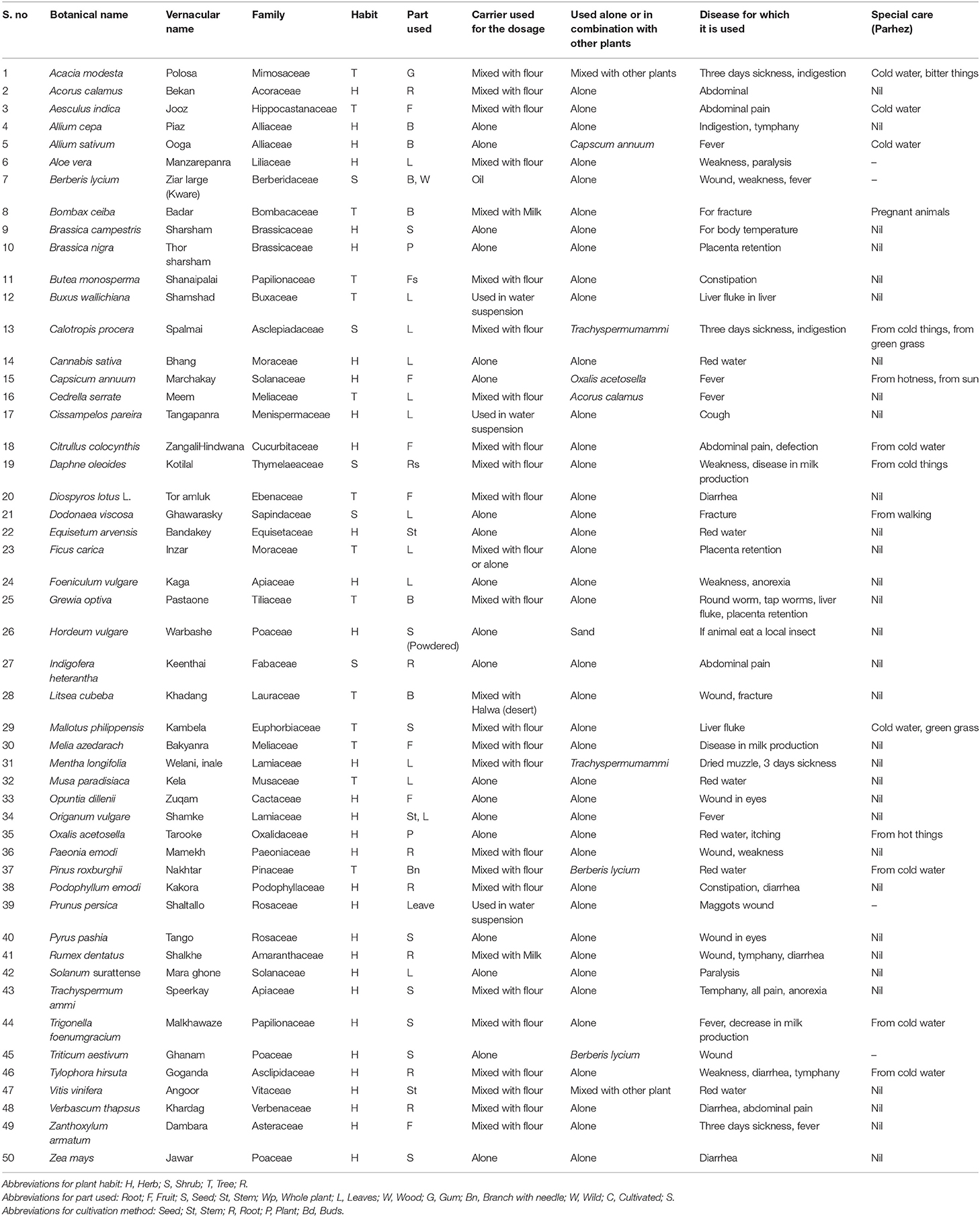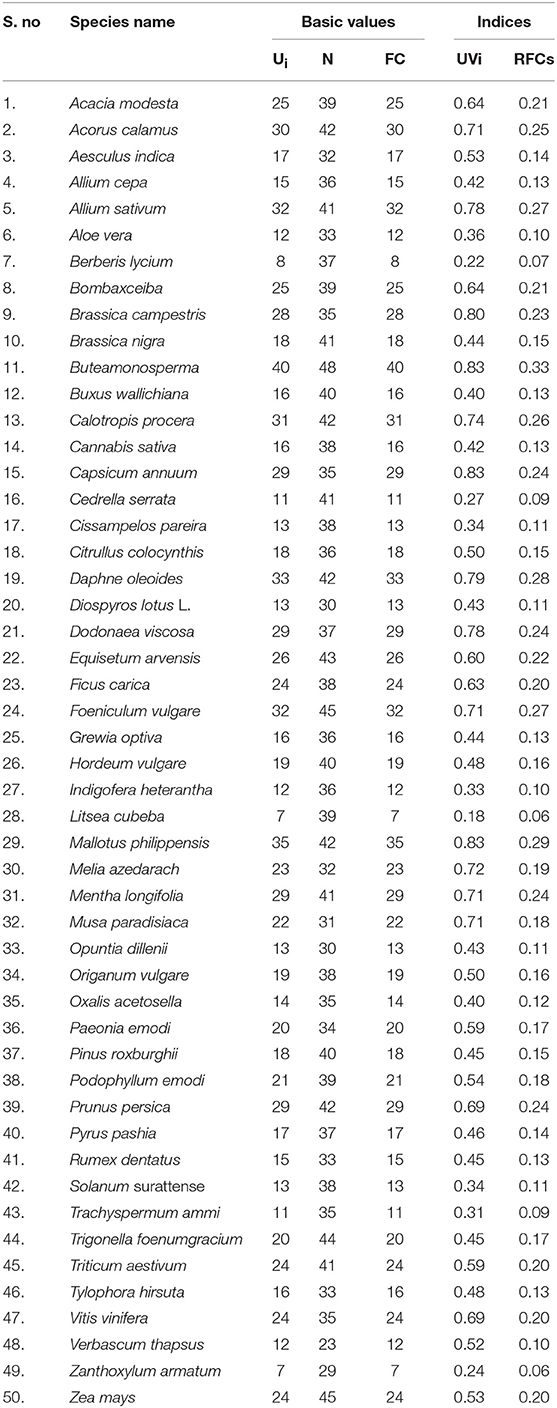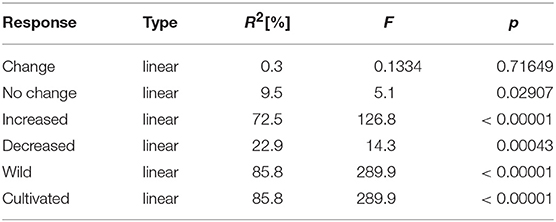- 1Department of Botany, Hazara University, Mansehra, Pakistan
- 2William L. Brown Center, Missouri Botanical Garden, St. Louis, MO, United States
- 3Department of Biology, University of São Paulo, São Paulo, Brazil
- 4Department of Biology, University of Missouri, St. Louis, MO, United States
Domestic animals play a very important role in the human civilization. Besides human being, plants are used as medicines for many domestic animals. The therapeutic practices are very common among the tribes of Chamla, rich in ethnoveterinary medicinal plants. Due to poor availability of modern healthcare facilities and poverty of indigenous people, they depend on local medicinal plants for the healthcare of their domestic animals. This study is the first attempt to document the indigenous knowledge and evaluate the conservation status of medicinal plants and practices of herbal remedies by the local people of Chamla Valley in the treatment of their livestock. Semi-structured questionnaire was used and 120 local inhabitants were interviewed to note the traditional practices regarding plant species uses. Well-known statistical indices, Use Value formula and Relative Frequency Citations were used for quantification of the recorded data. It was observed that 50 medicinal plants belonging to 38 families were reported, where Poaceae was the most cited. The common livestock are goats, sheep, buffalos, cows, bulls, and donkeys. Most of the herbs, which are used in livestock treatment, are wild and few plants are cultivated. The common livestock diseases are red water, 3 days sickness, diarrhea, tympany, and indigestion among others. Most of the plants are used in fresh condition. According to the results, Brassica nigra was used for placenta retention, Butea monosperma for constipation, Calotropis procera for indigestion and 3 days sickness. Canabis sativa, Cedrella serrata, Allium sativum, and Origanum vulgare were used for fever. The traditional plant collection techniques have resulted in huge losses of these valuable plant resources. The ethnobotanical conservation assessment revealed that due to increased exploitation and un-sustainable harvesting, 49% of these economically valued medicinal plant species are decreasing in last 30 years. Some of the plants are only present on high altitudes while they had been finished in the foothills like Paeonia emodi and Berberis lycium. Lack of scientific knowledge, ignorance, poverty, and joblessness, as well as land development, construction and fires, add more pressure on flora and fauna of the area and various species are under the threat of extinction.
Introduction
Livestock keeping is one of the vital economic sources forming integral part of the traditional tribal community. Animals are a source of calories in the form of meat, milk, and its derivatives for the livelihood of local people and also they are a source of earning. Livestock plays an important role in national economy of Pakistan (1), since the majority of the people of the current study area depends on agriculture and livestock production. Livestock is the largest contributor to overall agriculture value. The livestock owners have to rely on the herbal medicinal plant recipes being inherited by their predecessors generation to generation.
Dependency and sustainability of man and animal lives has been revolving around plants through their uses as foods, fibers, and shelter, as well as to control and ease diseases, which is an ancient and reliable practice (2). Ailments and medicinal plants vary in the world, hence their nature, frequency, and methods of administration can change in relation to geography, time and knowledge. Indigenously, different plants have been used to cure a disease or several diseases at a time, but toward the middle of 20th century the contribution of medicinal plants to medicine was reduced by approximately one fourth as research and development favored the use of synthetic chemicals. Now this trend is reversing once again in favor of plants, as they have been discovered to possess natural products that are chemically balanced, effective, less injurious with none or much less side effects (3). Pakistan, China, and India are the supreme users of medicinal plants. Their traditional practices of plant remedies date back at least 7,000 years (1). The influences of traditional medicine upon western medicine have been both indirect and direct (4).
Ethnoveterinary medicine, the scientific term for traditional animal health care, provides low-cost alternatives to allopathic drugs (2, 5). Research in such field is often undertaken as part of a community-based approach that serves to improve animal health and provide basic veterinary services in rural areas (6, 7). In addition, ethnoveterinary medicines cover people's knowledge, skills, methods, practices, and beliefs about the care of their animals (2). In many poor rural areas ethnoveterinary medicine can play an important role in animal production and livelihood development and often becomes the only available means for farmers to treat ill animals (8). These medicines provide valuable alternatives to and complement western-style veterinary medicine. During the late 1930, it was observed that cattle fed on spoiled sweet clover died from hemorrhage. On examination it was finally established that this hemorrhagic effect was due to a chemical, dicoumarin now known under the trademark dicoumarol. In 1941, synthesis of this anticoagulant agent was done by Link Stabmann and Huebner and then, it was beneficently employed (4).
Therefore, it is extremely necessary to document and disseminate indigenous knowledge in order to help and share the different uses of plants as animal health care and to promote different conservation measures. Thus, the aim of this study was to evaluate the Ethnoveterinary therapeutic practices and conservation status of the medicinal flora of Chamla Valley, Khyber Pakhtunkhwa, Pakistan. This is the first attempt to document the indigenous knowledge and evaluate the conservation status of medicinal plants and practices of herbal remedies by the local people of Chamla Valley in the treatment of their livestock.
Materials and Methods
Study Area
Buner District (34°26′34.83″N, 72°29′57.58″E) is located in Khyber Pakhtunkhwa Province, Pakistan and it was a part of Swat up to 1969. The region presents an area of 1,865 km2. Chamla valley has an area of 49 km2 and elevation of 670 m. The valley is drained by Chamla River which finally joins Indus River (9). Buner District is administratively divided into six tehsils namely: Daggar, Gadezi, Chagharzai, Gagra, Chamla, and Totalai. Elevation varies from 366 meters in Totalai in the south to 2,911 meters of the Dosara peak in the North. Total population of Buner district is more than 0.9 million.
This region was chosen, because economically the majority of people are poor and agriculture and livestock is the main source of livelihood of the population, where they have their own treatment system for most of the diseases of their domestic animals. Therefore, this region is an excellent study model for the documentation and dissemination of indigenous knowledge in order to help and share the different uses of plants in animal health care. The main livestock include cattle, buffalos, sheep, goats, camels, horses, asses, and mules.
Data Collection
Twelve villages were randomly selected from the upper, middle, and lower areas. In each village, randomly 10 inhabitants were interviewed. Out of these ten, five were common persons involved in farming practices while five were the expert in the use of these plants for the treatment of livestock diseases.
The work was initiated in the result of discussion with experts of knowledge of medicinal plants and experts of study area for identifying and conserving this precious source of natural resources. In detail, the study was conducted in the following steps: (i) Collection of baseline information and Sampling design—Field surveys were carried out and interviews of the local informants were conducted. During field trips, people including local traditional practitioners, veterinary doctors, farmers, and other local respondents were interviewed on random basis for the traditional uses of indigenous plants in curing ethnoveterinary diseases. Semi-structured questionnaire was used to note the traditional knowledge regarding plant species uses [sensu (10)]; (ii) Identification—The samples of the plants were identified in different departments, such as PCSIR (Peshawar), Pakistan Forest Institute (Peshawar), and Department of Botany, University of Peshawar. After filed surveys, different analyzes related to the use of the plants in the animal health care were used (see Statistical analysis below) to observe the relevance of each species in the animal health care.
Statistical Analyses
Use Value (UVi). UVi, the Use Value of a plant species was calculated by using the formula [8];
Ui = Use reports cited for a particular plant species by each respondent and Ni = Total informants interviewed for a particular plant species.
Relative frequency of citations (RFCs). RFCs index was used to assess the traditional uses and medicinal value of each species in the area (11).
FCs = No. of local respondents who use the taxa traditionally and N is the total number of respondents of in the study (in this study, n = 120).
Multivariate ordination analyses, “principal components analysis” (PCA) and species response curve (SRC), were used to evaluate differences in the conservation status and nature of the plant species reported. A species response curve (SRC) was drawn to distinguish significance level of diseases categories based on the use reports of its sub categories treated with medicinal plant species. All analyses were run in CANOCO 5 (11, 12).
Results
Demography
Interviews were conducted from different fields of life viz; local traditional practitioners, veterinary doctors, farmers, and other local respondents. The current study showed that farmers have a preference to collect medicinal plants directly from the field, since they can easily collect and use the plants. Each village of the study area has many expert persons in livestock treatment. The survey showed that most of the people have some information about the use of herbal medicine for the treatment of their livestock, where this information is usually passed down from their parents or elders.
Floristic Contribution in Ethnoveterinary Practices
A total of 50 medicinal plants belonging to 38 families have been reported by the local respondents (Table 1), where Poaceae was the most cited family. In these ethnoveterinary medicinal plant species, 50% were herbaceous growth habit, 28% were trees, and 22% were shrubs. Out of these 50% medicinal plants, 70% were wild in nature and 30% were cultivated (Table 2). All of the understory medicinal plant species were used for curing various veterinary ailments. The common livestock diseases are red water (Kalangari), 3 days sickness (Taqo), diarrhea (Reekh), tympany (parsob), and indigestion (Charmekh) among others (Table 1).
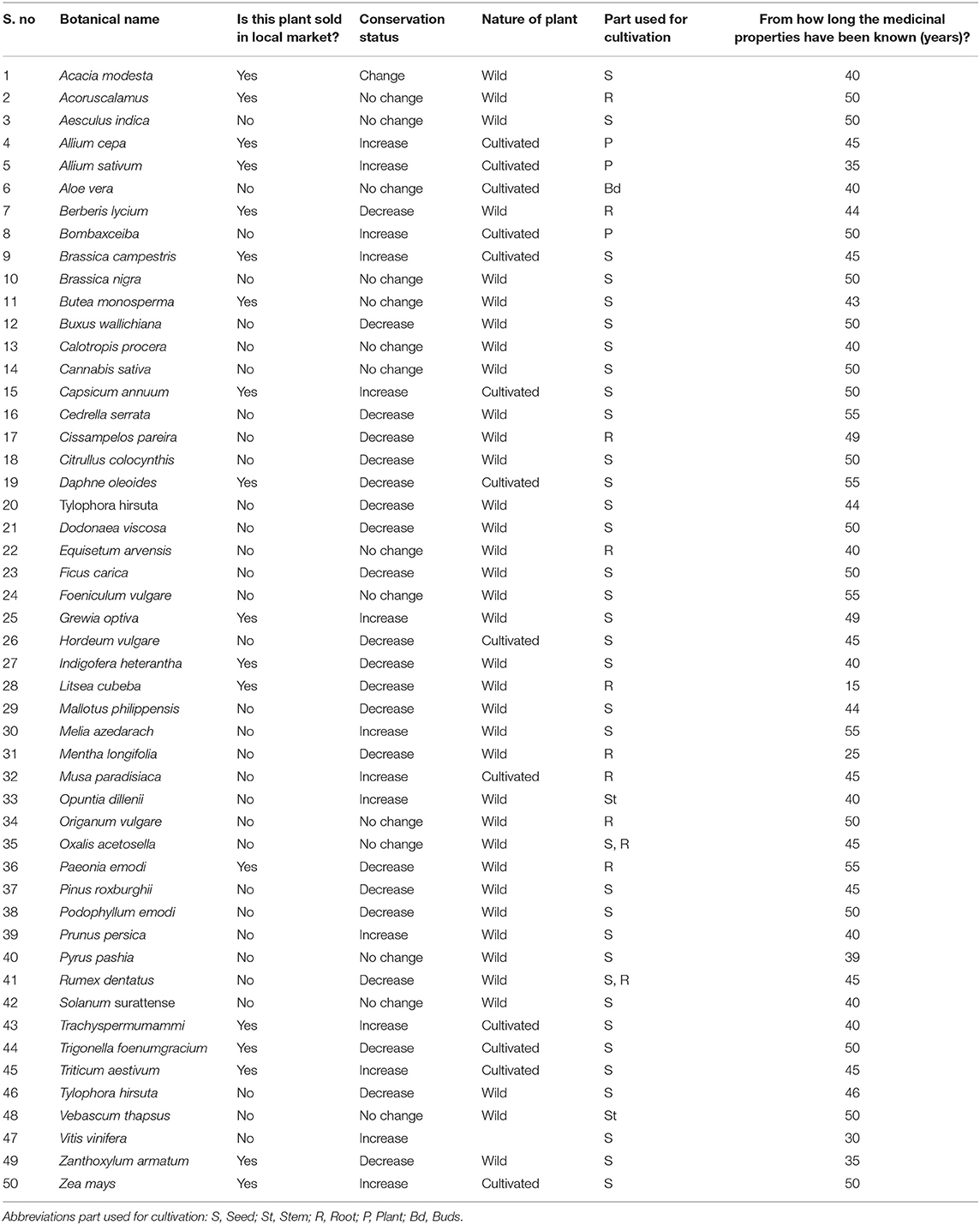
Table 2. Market availability, status, nature, part for cultivation, and therapeutic practices of the medicinal plants recorded from Chamla Valley.
Most of the plants are used in fresh condition. According to the results, in some cases for a single disease many plants were used. Some medicinal plants are used for single disease, such as Canabis sativa, Cedrella serrate, and Origanum vulgare were used for fever, Brassica nigra was used for placenta retention, Butea monosperma for constipation. On the other hand, species cited for multi disorders were Berberis lycium for wound, weakness, and fever, Acacia modesta, Calotropis procera for 3 days sickness and indigestion, Daphne oleoides for weakness and disease in milk production, Grewia optiva for round worm, tap worms, liver fluke, and placenta retention, Trigonella foenumgracium for fever, decrease in milk production (Table 1). In addition, we provide some chemical compounds present in some plant species used by local respondents (see Table 3).

Table 3. Chemical compounds present in some plant species used by local respondents of Chamla Valley, KP, Pakistan.
Carrier Used for the Dosage
The local community members used different carriers for making the traditional medicine, i.e., flour, water, oil, milk, halwa (a traditional dessert) to treat the diseases. Out of 50 medicinal plants, 24 are used with flour (Table 1). It is important to mention that these ethnoveterinary approaches are practiced from more than five decades (25–55 years) (Table 4).
Special Care (Parhez)
Most of the plants are used in fresh condition and those plants that are used in dry condition are at the top of the mountains and they cannot be obtained immediately. In addition, most of these plants are not available in the market. Plants are mostly given singly and usually there is no special care in the treatment process, but few plants need special care, locally called as “parhez” (Table 1). Generally, effects of the drugs are mostly quick and the common animal diseases are red water, 3 days sickness, diarrhea, tympani, and indigestion.
Use Value (UVi) and Relative Frequency Citations (RFCs)
The UVi ranged from 0.18 to 0.83 (Table 4). The plants with highest value of UVi were Butea monosperma and Mallotus philippensis (UVi = 0.83), followed by Brassica campestris (0.80), Daphne oleoides (0.79), Allium sativum, and Dodonaea viscosa (both with 0.78), respectively. On the other hand, the plant with the lowest value was Litsea cubeba (0.18). Relative frequency citation ranged from 0.06 to 0.33 (Table 4). Based on the RFC values, the most valuable and cited medicinal plant species by the traditional practitioners and local respondents were Butea monosperma (RFCs = 0.33), Mallotus philippensis (0.29) and Daphne oleoides (0.28). The plants with the lowest RFCs were Litsea cubeba and Zanthoxylum armatum (RFCs = 0.06).
Principle Components Analysis (PCA)
Principle components analysis (PCA) was determined to examine the correlation between plant species and treated ailments (disease categories). The PCA results revealed that Allium cepa, Allium sativum, Bombax ceiba, Brassica campestris, Capsicum annuum, and Melia azedarach were most frequently found with positive and significant correlation with increased population; and Buxus wallichiana, Cedrella serrata, Cissampelos pareira, Citrullus colocynthis, Daphne oleoides, and Tylophora hirsuta was cited as decreased species. Acacia modesta, Acorus calamus, Aesculus indica, and Berberis lycium were positive and significant in correlation with wild nature and all these species were most frequently found in wild habitats. Allium cepa, Allium sativum, and Aloe vera were found cultivated. All the remaining species-diseases correlations are illustrated in Figure 1.
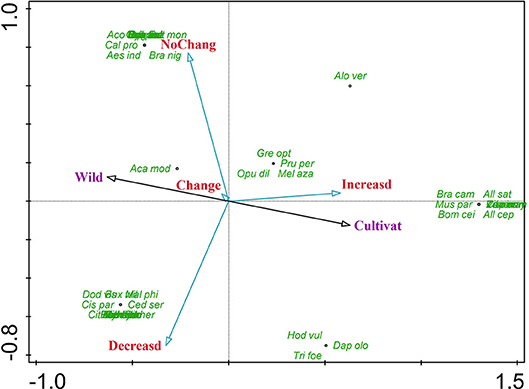
Figure 1. Principle component analysis showing the correlation between plant species and their variables.
Species Response Curve (SRC)
The analysis clearly indicates highly significant differences (p < 0.00001) for increased population variable (conservation status) in comparison with all other variables due to their maximum frequency as shown in Figure 2A. Additionally, this disease category also showed maximum response (72.5%) and computed value (F = 126.8) as well. Nevertheless, wild and cultivated frequency of species (Figure 2B) also showed highly significance (p < 0.00001) due to its citations frequency with a response percentage (85.8%) and (85.8%) and computed value (F = 289.9) and value (F = 289.9), respectively. Furthermore, the remaining variables showed non-significant differences as mentioned in the Table 5.
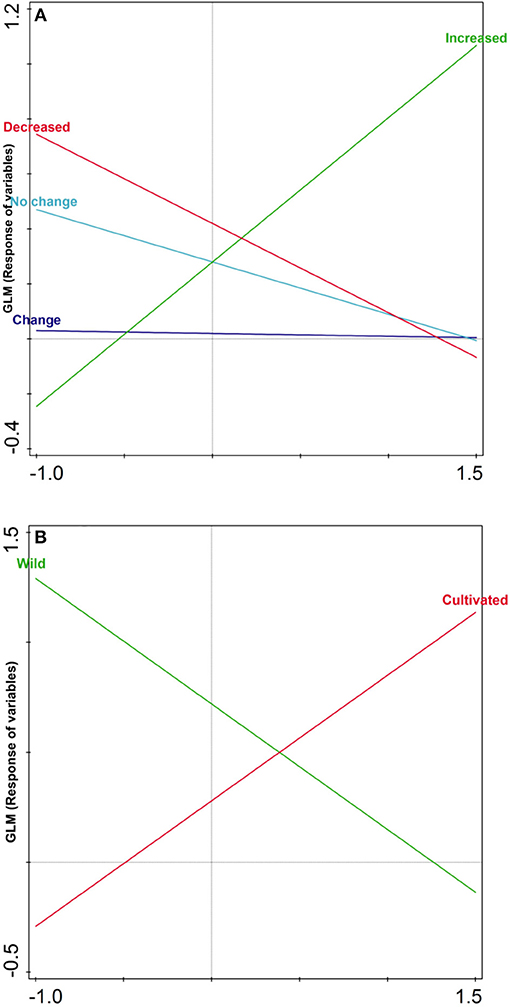
Figure 2. Species response curve shows the significance level among various variables conservation status (A) and nature of plant (B) on the basis of their frequency.
Status of Ethnoveterinary Medicinal Plants
At high altitude, high diversity in medicinal plants population was found. While, as we go toward the plain area, the number of species decreases. The population of most of medicinal plants has been decreased in last 30 years (Table 4). Only few plants, which are cultivated or not grazed by animals, are increased.
Discussion
Floristic Medicinal Contribution
Pakistan has a wide variety of flora and fauna, where flora contains about 6,000 species of phanerogams (1). In Pakistan the local populations of different regions have century's old knowledge and traditional practices of most of the plants occurring in those regions. This local knowledge of plants has been transferred from generation to generation through verbal communication and personal experience. The local people utilized locally available herbal recipes due to many reasons e.g., the people are poor and cannot afford modern veterinary medicine and there is a long distance between their residence and the area where some modern veterinary facilities are available. Due to this reason the traditional herbal medicine is the first option for the people of Chamla Valley (Study area). Harun-or-Rashid et al. (35) reported from Bangladesh that lack of access to modern veterinary facilities and because of the high prices of medicines, most farmers rely on traditional healers for cure of livestock diseases. Due to this reason the traditional herbal medicine is the first option of the people of Chamla Valley and they depend on medicinal plants to cure various diseases of human and animals.
In the present study, herbal healers and local respondents reported a total of 50 medicinal plants used in the treatment of livestock diseases. These medicinal plants are used for various ailments. Some medicinal plants are used for single disease, while some are used for many diseases. Also species cited for multi disorders were Acacia modesta, Calotropis procera for 3 days sickness and indigestion, Daphne oleoides for weakness and disease in milk production, Grewia optiva for roundworm, tap worms, liver fluke, and placenta retention. Similarly, Jabbar et al. (36) and Tabassam et al. (37) have reported different plant species used in animal treatment from different parts of Pakistan. Dilshad et al. (38) has reported 66 plant species from Sargodha district of Pakistan and Farooq et al. (39) reported 18 plant species representing 14 families to cure parasitic diseases of livestock from Cholistan desert of Pakistan. In another similar study in Mansehra district, a selected hilly area of Pakistan, Sindhu et al. (40) reported 35 plant species belonging to 25 families [also see Ole-Midron (41)].
Use Value and Relative Frequency Citations
The medicinally used plants with highest use values were Butea monosperma, Mallotus philippensis, Brassica campestris and Daphne oleoides. Greater use values of these mentioned medicinal plants might be due to their widespread distribution and also due to local practitioners' awareness, which makes those plants as the first choice for ailment (11). Based on the RFC values, the most valuable and cited medicinal plant species by the traditional practitioners and local respondents were Butea monosperma, Mallotus philippensis, and Daphne oleoides. Maximum relative frequency citations clarify the facts that the cited plants species are well familiar to the number of traditional drivers (42) and they should be further evaluated in pharmacognostic studies (43).
Conservation of Medicinal Plants
The number of ethnoveterinary medicinal plant species is decreasing, as showed by this study. One reason for this is the excessive and unwise utilization, over grazing, climate change, increase in population, poor method of collection like dig out the whole plant, market pressure and deforestation. The local people cut down the forests for the cultivation of orange fruits and other plants because it is the high source of income for local people. Some plants are collected from the mountains, brought to local market by the local people and then transferred to the major cities. The wild plants are seriously endangered. Some plants are only present only at high altitude such as Maban area while in lower mountains they had been vanished and extinct. Local people want to increase their area of cultivation and for this purpose they burn the whole forest, affecting the whole plant population. For instance, besides being cut off indiscriminately, the seedlings of the Pinus were also destroyed during burning of the forest.
The existence of forest is essential for the life of these medicinal plant species, an awareness program in the region about the status of indigenous flora, sustainable plants collection and conservation of important medicinal plants will yield better outcomes (9). The indigenous community should be involved in conservation practices and the local staff, local stakeholders, and plant collectors should be aware about the conservation of plant resources of the area. Sher et al. (44) indicated that the investigated area of district Buner is under heavy deforestation, biotic interference, and overgrazing pressure. Resultantly, valuable economic and medicinal plants of the area are reducing. Sustainable utilization, suitable management and conservation of the flora of the area are highly suggested.
Conclusions
This is the first study to collect and organize data about the medicinal plants that are used in the treatment of livestock diseases and identify those species of plants that are endangered due to indiscriminate usage in Buner district, Pakistan. The results showed that (i) the most common livestock diseases are red water, tymphany, constipation, diarrhea, fever, and indigestion, (ii) Butea monosperma, Mallotus philippensis, Brassica campestris, and Daphne oleoides are the most representative medicinally plant species, and (iii)Paeonia emodi, Berberis lyceum, and Pinus roxburghii are facing very strong pressure due to their indiscriminate harvesting by the local people.
Therefore, we suggest that there is dire need to protect forest and conserve the habitats for flora and fauna. For this, government and NGOs need to implement strong programs with the participation of local people, which need to be made aware of the importance of conserving the precious forest resources and taking part in the plantation for future generations.
Author Contributions
KK and NA conceived designed the experiment. KK performed the experiment. IUR analyzed the data. KK, IUR, and NA wrote the manuscript. EC and FI commented and made the final suggestions in the manuscript.
Conflict of Interest Statement
The authors declare that the research was conducted in the absence of any commercial or financial relationships that could be construed as a potential conflict of interest.
Acknowledgments
The authors gratefully acknowledge the local community members of the study area for sharing their important traditional medicinal knowledge. This study was financed in part by the Coordenação de Aperfeiçoamento de Pessoal de Nível Superior—Brasil (CAPES)—Finance Code 001 (EC).
References
1. Iqbal Z, Jabbar A, Akhtar MS, Muhammad G, Lateef M. Possible role of ethnoveterinary medicine in poverty reduction in Pakistan: use of botanical anthelmintics as an example. J Agric Soc Sci. (2005) 1:187–95.
2. McCorkle CM. An introduction to ethnoveterinary research and development. J Ethnobiol. (1986) 6:129–49. doi: 10.3362/9781780444895.001
3. Arshad M, Rao AR. Medicinal Plants of cholistan desert, medicinal plants of Pakistan. Med GD. (1998) 1:325–8.
5. Guèye EF. Ethnoveterinary medicine against poultry diseases in African villages. Worlds Poult Sci J. (1999) 55:187–98. doi: 10.1079/WPS19990013
6. McGaw LJ, Eloff JN. Ethnoveterinary use of southern African plants and scientific evaluation of their medicinal properties. J Ethnopharmacol. (2008) 119:559–74. doi: 10.1016/j.jep.2008.06.013
7. van der Merwe D, Swan GE, Botha CJ. Use of ethnoveterinary medicinal plants in cattle by Setswana-speaking people in the Madikwe area of the North West Province of South Africa. J S Afr Vet Assoc. (2001) 72:189–96. doi: 10.4102/jsava.v72i4.651
8. Akhtar M, Iqbal Z, Khan M, Lateef M. Anthelmintic activity of medicinal plants with particular reference to their use in animals in the Indo-Pakistan subcontinent. Small Rumin Res. (2000) 38:99–107. doi: 10.1016/S0921-4488(00)00163-2
9. Hamayun M, Khan A, Khan MA. Common medicinal folk recipes of District Buner, NWFP, Pakistan. J Bot. (2003) 31:56–64.
10. Ijaz F. Biodiversity and Traditional Uses of Plants of Sarban Hills, Abbottabad. M.Phil thesis, Department of Botany, Hazara University Mansehra (2014).
11. Rahman IU, Ijaz F, Afzal A, Iqbal Z, Ali N, Khan SM. Contributions to the phytotherapies of digestive disorders: traditional knowledge and cultural drivers of Manoor Valley, Northern Pakistan. J Ethnopharmacol. (2016) 192:30–52. doi: 10.1016/j.jep.2016.06.049
12. Rahman IU, Afzal A, Iqbal Z, Ijaz F, Ali N, Bussmann RW. Traditional and ethnomedicinal dermatology practices in Pakistan. Clin Dermatol. (2018) 36:310–19. doi: 10.1016/j.clindermatol.2018.03.016
13. Rastogi RP, Mehrotra BN. Compendium of Medicinal Plants, Vol. 2. New Delhi: Central Drugs Research Institute, Lucknow and Publication and Information Directorate (1979). p. 833.
14. Roshan N, Savitri P. Review on chemical constituents and parts of plants as immunomodulators. Res J Pharma Biol Chem Sci. (2013) 4:76–89.
15. Gulfraz M, Qadir G, Nosheen F, Parveen Z. Antihyperglycemic effects of Berberis lyceum Royle in alloxan induced diabetic rats. Diabetol Croat. (2007) 36–3:49–54.
16. Mustafa KG, Ganai BA, Akbar S, Dar MY, Tantry MA, Masood A. The extracts of Berberis lycium and diabetes mellitus in alloxan monohydrate induced diabetic rats. J Pharm Res. (2011) 4:2570–73.
17. Watanabe T, Rajbhandari KR, Malla KJ, Yahara S. A Handbook of Medicinal Plants of Nepal. Bangkok: Kobfa Publishing Project (2005). p. 262.
18. Dahab MM, Musa EM, Osman EA, Koko WS, Almgboul AZ, Khogali MS. Antigiardial activity and toxicological exploration of Cannabis sativa extracts. J For Prod Ind. (2013) 2:24–9.
19. Uddin G, Ullah W, Siddiqui BS, Shah SQ. Grewialin and optivanin new constituents from the stem bark of Grewia optiva Drummond ex Burret (Tiliaceae). Nat Prod Res. (2013) 27:215–22. doi: 10.1080/14786419.2012.666749
20. Samantha AK, Agarawal P. Application of natural dyes on textiles. Ind J Fibre Textile Res. (2009) 34:384–99.
21. Hamayun M, Afzal S, Khan MA. Ethnopharmacology, indigenous collection and preservation techniques of some frequently used medicinal plants of Utror and Gabral, District Swat, Pakistan. Afr J Trad Compl Alter Med. (2006) 3:57–73. doi: 10.4314/ajtcam.v3i2.31158
22. Slatnar A, Klancar U, Stampar F, Veberic R. Effect of drying of figs (Ficus carica L.) on the contents of sugars, organic acids, and phenolic compounds. J Agric Food Chem. (2011) 59:11696–702. doi: 10.1021/jf202707y
23. Vallejo F, Marin JG, Tom'as-Barberan FA. Phenolic compound content of fresh and dried figs (Ficus carica L.). Food Chem. (2012) 130:485–92. doi: 10.1016/j.foodchem.2011.07.032
24. Liu F, Yang Z, Zheng X, Luo S, Zhang K, Li G. Nematicidal coumarin from Ficus carica L. J Asian Pacific Entomol. (2011) 14:79–81. doi: 10.1016/j.aspen.2010.10.006
25. Saeed MA, Sabi A. Irritant potential of triterpenoids from Ficus carica leaves. Fitoterapia. (2002) 73:417–20. doi: 10.1016/S0367-326X(02)00127-2
26. Arya V, Gupta R, Gupta VK. Pharmacognostic and phytochemical investigations on Pyrus pashia Buch.-Ham. ex D. Don stem bark. J Chem Pharm Res. (2011) 3:447–56.
27. Janbaz KH, Ahsan MZ, Saqib F, Imran I, Zia-Ul-Haq M, Rashid MA, et al. Scientific basis for use of Pyrus pashia Buch.-Ham. ex D. Don. Fruit in gastrointestinal, respiratory and cardiovascular ailments. PLoS ONE. (2015) 10:e0118605. doi: 10.1371/journal.pone.0118605
28. Gulluce M, Karadayi M, Guvenalp Z, Ozbek H, Arasoglu T, Baris O. Isolation of some active compounds from Origanum vulgare L. ssp. vulgare and determination of their genotoxic potentials. Food Chem. (2012) 130:248–263. doi: 10.1016/j.foodchem.2011.07.024
29. Azcan N, Kara M, Demirci B, Baser K, Huesnue C. Fatty acids of the seeds of Origanum onites L. and O. vulgare L. Lipids. (2004) 39:487–9. doi: 10.1007/s11745-004-1255-x
30. Lin Y, Wang C, Shiao Y, Liu T, Wang W. Benzolignanoid and polyphenols from Origanum vulgare. J Chin Chem Soc. (2003) 50:1079–83. doi: 10.1002/jccs.200300153
31. Pardo F, Perich F, Torres R, Monache DF. Phytotoxic iridoid glucosides from the roots of Verbascum thapsus. J Chem Ecol. (1998) 24:645–53. doi: 10.1023/A:1022338118561
32. EMEA (European Medicines Agency Evaluation of Medicines for Human Use). Assessment Report on Verbascum thapsus L., V. densiflorum Bertol.; V. phlomoides L., With traditional Use. London (2009).
33. Singh G, Kapoor IP, Singh P, de Heluani CS, de Lampasona MP, Catalan CA. Department of Chemistry, DDU, Gorakhpur University, Gorakhpur 273009, India. Int J Food Prop. (2013) 16:288–300.
34. Barkatullah, Ibrar M, Muhammad N. Evaluation of Zanthoxylum armatum DC for in-vitro and in-vivo pharmacological screening. Afr J Pharm Pharmacol. (2011) 5:1718–23. doi: 10.5897/AJPP11.405
35. Harun-or-Rashid M, Tanzin R, Ghosh KC, Jahan R, Khatun MA, Rahmatullah M. An ethnoveterinary survey of medicinal plants used to treat cattle diseases in Birishiri area, Netrakona district, Bangladesh. Adv Nat Appl Sci. (2010) 4:10–13.
36. Jabbar A, Raza MA, Iqbal Z, Khan MN. An inventory of the ethnobotanicals used as anthelmintics in the southern Punjab (Pakistan). J Ethnopharmacol. (2006) 108:152–4. doi: 10.1016/j.jep.2006.04.015
37. Tabassam SM, Iqbal Z, Jabbar A, Ud-Sindhu Z, Abbas RZ. Documentation of ethnoveterinary practices and evaluation of Azadirachta indica for treatment of sheep mange. In: 12th AAAP Animal Science Congress. Busan.
38. Dilshad SMR, Rehman NU, Ahmad N, Iqbal A. Documentation of ethnoveterinary practices for mastitis in dairy animals in Pakistan. Pak Vet J. (2010) 30:167–71. doi: 10.1097/QCO.0b013e3283638104
39. Farooq Z, Iqbal Z, Mushtaq S, Muhammad G, Iqbal MZ, Arshad M. Ethnoveterinary practices for the treatment of parasitic diseases in livestock in Cholistan desert (Pakistan). J Ethnopharmacol. (2008) 118:213–19. doi: 10.1016/j.jep.2008.03.015
40. Sindhu ZUD, Iqbal Z, Khan MN, Jonsson NN, Siddique M. Documentation of ethnoveterinary practices used for treatment of different ailments in a selected hilly area of Pakistan. Int J Agric Biol. (2010) 12:353–8.
41. Ole-Miaron JO. The Maasai ethnodiagnostic skill of livestock diseases: a lead to traditional bioprospecting. J Ethnopharmacol. (2003) 84:79–83. doi: 10.1016/S0378-8741(02)00283-0
42. Ijaz F, Iqbal Z, Rahman IU, Alam J, Khan SM, Shah GM, et al. Investigation of traditional medicinal floral knowledge of Sarban Hills, Abbottabad, KP, Pakistan. J Ethnopharmacol. (2016) 179:208–33. doi: 10.1016/j.jep.2015.12.050
43. Ahmed J. Floristic Diversity and Ethnobotanical Appraisal of Tehsil Oghi, District Mansehra, Pakistan. BS thesis, GPGC, Mansehra (2017).
Keywords: traditional knowledge, medicinal plants, animal care, ethnomedicinal quantification, statistical indices, conservation, Buner, Pakistan
Citation: Khan K, Rahman IU, Calixto ES, Ali N and Ijaz F (2019) Ethnoveterinary Therapeutic Practices and Conservation Status of the Medicinal Flora of Chamla Valley, Khyber Pakhtunkhwa, Pakistan. Front. Vet. Sci. 6:122. doi: 10.3389/fvets.2019.00122
Received: 30 August 2018; Accepted: 01 April 2019;
Published: 16 May 2019.
Edited by:
Nora Mestorino, National University of La Plata, ArgentinaReviewed by:
Arturo Anadón, Complutense University of Madrid, SpainRicardo Enrique Toso, National University of La Pampa, Argentina
Copyright © 2019 Khan, Rahman, Calixto, Ali and Ijaz. This is an open-access article distributed under the terms of the Creative Commons Attribution License (CC BY). The use, distribution or reproduction in other forums is permitted, provided the original author(s) and the copyright owner(s) are credited and that the original publication in this journal is cited, in accordance with accepted academic practice. No use, distribution or reproduction is permitted which does not comply with these terms.
*Correspondence: Inayat Ur Rahman, aGFqaWJvdGFuaXN0QG91dGxvb2suY29t; aXJhaG1hbkBtb2JvdC5vcmc=
orcid.org/0000-0003-3312-7975
 Khalid Khan1
Khalid Khan1 Inayat Ur Rahman
Inayat Ur Rahman Eduardo Soares Calixto
Eduardo Soares Calixto Niaz Ali
Niaz Ali